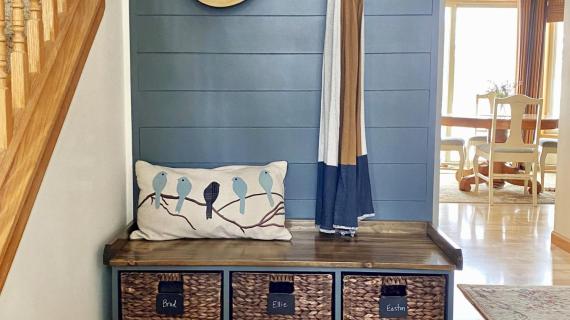
Build your own entryway bench in a custom size. This tutorial will walk you through the steps, with a video of the build, step by step diagrams, and even a free configurator to help you design your own! This entryway bench is a classic design, turning any entry into a mudroom!
RELATED: Matching wall organizer plan is available for free here.
Pin for Later!


Preparation
- Plywood Pieces for Carcass (see step 1)
- 1x3s for bay supports and trim, you'll need approximately 5 times the overall width of the bench
- 1-1/4" pocket hole screws
- 1-1/4" brad nails
- wood glue
- Primer and paint or stain for finishing
Carcass cuts are determined through the configuration Ana's Design App in Step 1.
Bay supports are equal to the width of your bays.
Top and bottom trim should be cut to fit for a perfect trimout.
Instructions
Step 1
Design Your Bench
Use our free configurator tool here to design your bench carcass, here are the parameters to set:
- Depth - recommend 15-1/4" depth, but can use 20-1/4" and 23-1/4" too
- Width - any width up to 90"
- Height - recommend 18"
- Bays - as many bays as desired, but keep bay width less than 36" as it is supportive of the top and will keep the top from sagging
- Top - yes
- Bottom - yes
- Space Under Bottom - 2-1/4" for 1x3 base trim (as I did) or 3-1/4" for 1x4 base trim
Step 2
Creating a Cut List and Shopping List from Your Configuration
Once you have your configuration done and the drawing printed, use the drawing to create a cut list by printing it out, and drawing all the added parts on.
Once you have a cut list, you can create a shopping list from the cut list.
Cutting the Plywood Carcass Pieces
Rip the 3/4" plywood into strips the desired depth of the bench. Then cross cut the strips to create the pieces needed in the plans.
Apply edge banding to the front edges of the pieces and trim off with a razor. Sand rough edges.
Step 3
Main Carcass Assembly
On the bottom shelf, drill three 3/4" pocket holes at each end (four if you went with a 23-1/4" wide carcass).
Attach bottom shelf to the two sides, with 2-1/4" gap underneath, using 1-1/4" pocket hole screws.
Then attach dividers to bottom shelf using 1-1/4" brad nails and wood glue. TIP: Use the bay supports as spacers to guide you in placing the dividers as shown in the video.
Step 4
Step 5
Step 6
Step 7
Step 9
Then I used a leaf blower to blow off the sanding residue and wiped with a just damp washcloth.
Then I primed using a small roller and brush.





































Comments
VWalsh
Wed, 08/25/2021 - 10:41
Adrian's bench
Adrian's bench
kishoremsk
Tue, 12/27/2022 - 19:00
Sag in the middle?
Nice simple design. I am new to wood working and like the simple designs here. For this bench, wouldn't all the weight fall on the two side end pieces? I am planning a 48" wide bench but worried it would sag in the middle? Any thoughts.
kishoremsk
Tue, 12/27/2022 - 19:00
Sag in the middle?
Nice simple design. I am new to wood working and like the simple designs here. For this bench, wouldn't all the weight fall on the two side end pieces? I am planning a 48" wide bench but worried it would sag in the middle? Any thoughts.